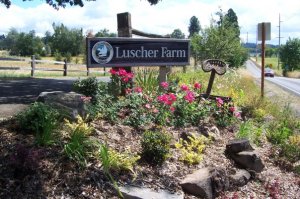This week’s Good News Monday features Luscher Farm in Lake Oswego, just outside Portland, Oregon. This farm was suggested to blogger, Julie Brothers, as a great example of an innovative effort by a group of people who truly are making a difference in the quality of our food supply. A visit to the farm confirmed the area’s excitement over the program.
Perhaps the most profound fact about Luscher Farms is that it is owned and run by the Lake Oswego Department of Parks and Recreation for the benefit of its citizens. It includes an organic demonstration garden and teaching facility, a living flower museum, 180 community garden plots and indigenous insectaries. This farm provides classes in sustainable practices. It promotes a real-time connection to the land and encourages local food production and preservation of rural open space.
Luscher Farms has local partners who support the project financially, and they use volunteer labor to work the farm. They endorse innovative farming practices to accommodate successful organic farming, such as straw bale gardening (a technique used for gardening in limited space) http://farmforklife.com/voice/Oregon-Tilth2#voice. Additionally, this farm has developed a sustainable community farming model that other cities can follow (http://farmforklife.com/voice/Lusher-Farm).
This successful community gardening project is indeed good news. It is evidence that it is possible for communities to control what they eat and to ensure that any effort to produce food does not harm the environment. Practices such as these help us to live green, be green.
Luscher Farms is an innovative effort in sustainable gardening.
Source for this article is http://www.huffingtonpost.com/julie-brothers/luscher-farm-lake-oswego_b_1945609.html?utm_hp_ref=food-safety.




